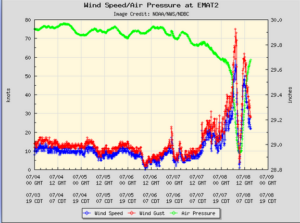Hurricane Francine neared the coast of Louisiana on Wednesday morning. At 11:00 a.m. EDT on Wednesday the center of Hurricane Francine was located at latitude 28.0°N and longitude 92.7°W which put the center about 150 miles (240 km) southwest of Morgan City, Louisiana. Francine was moving toward the northeast at 13 m.p.h. (20 km/h). The maximum sustained wind speed was 90 m.p.h. (145 km/h) and there were wind gusts to 105 m.p.h. (165 km/h). The minimum surface pressure was 976 mb.
A Hurricane Warning is in effect for the portion of the coast from the Vermilion/Cameron Line to Grand Isle, Louisiana
A Hurricane Watch is in effect for New Orleans, Lake Pontchartrain and Lake Maurepas.
A Tropical Storm Warning is in effect for the portion of the coast from Sabine Pass to the Vermilion/Cameron Line, Louisiana. A Tropical Storm Warning is in effect for the portion of the coast from Grand Isle, Louisiana to the Alabama/Florida border. The Tropical Storm Warning includes New Orleans, Lake Pontchartrain and Lake Maurepas.
Hurricane Francine maintained its intensity as it moved closer to the coast of Louisiana on Wednesday morning. An upper level trough over the South Central U.S. was producing southwesterly winds that were blowing toward the top of Francine’s circulation. Those winds were causing the vertical wind shear to increase. In addition, the circulation around the western side of Hurricane Francine was pulling drier air into the southern part of Francine’s circulation. Francine maintained its intensity even with the effects of the increased wind shear and drier air.
The effect of the vertical wind shear and the drier air also affected the structure of Hurricane Francine. A large circular eye with a diameter of 45 miles (75 km) was at the center of Francine’s circulation. The eye was surrounded by a broken ring of thunderstorms and the strongest winds were occurring in that ring of storms. The break in the ring of thunderstorms was south of the eye of Hurricane Francine. Storms near the center of Francine generated upper level divergence that pumped mass away to the northeast of the hurricane. The removal of mass in the upper levels almost balanced the inflow of mass in the lower levels and the surface pressure remained nearly steady.
The wind shear and drier air also affect the distribution of thunderstorms in Hurricane Francine. Thunderstorms were occurring in bands in the northern and eastern sides of Francine’s circulation. Bands in the southern and western sides of Hurricane Francine consisted primarily of showers and lower clouds.
The size of the circulation around Hurricane Francine remained steady. Winds to hurricane force extended out 40 miles (65 km) from the center of Francine’s circulation. Winds to tropical storm force extended out 115 miles (185 km) from the center of Hurricane Francine.
The Hurricane Intensity Index (HII) for Hurricane Francine was 13.9. The Hurricane Size Index (HSI) was 13.5 and the Hurricane Wind Intensity Size Index (HWISI) was 27.4. Hurricane Francine was similar in size and intensity to Hurricane Hanna when Hanna hit South Texas in 2020.
Hurricane Francine will move through an environment marginally favorable for intensification during the next 18 hours. Francine will move over water where the Sea Surface Temperatures are near 30°C. However, the upper level trough over the South Central U.S. will cause moderate vertical wind shear. The drier air in the southern half of Francine’s circulation will also inhibit intensification. Hurricane Francine is likely to maintain its current intensity during the next few hours until it reaches Louisiana.
Hurricane Francine will move between a high pressure system that extends from the western Atlantic Ocean to the Gulf of Mexico and the upper level trough over the South Central U.S, The high pressure system and the upper level trough will steer Francine toward the northeast during the next 24 hours. On its anticipated track, the center of Hurricane Francine will make landfall on the southeast coast of Louisiana late on Wednesday afternoon.
Hurricane Francine will bring strong winds and heavy rain to Louisiana. Francine will be capable of causing serious damage. Widespread outages of electricity are likely. Heavy rain is likely to cause flash floods. The heaviest rain will fall as the center of Francine’s circulation approaches a given location. Hurricane Francine will also drop heavy rain over parts of Mississippi, South Alabama and Northwest Florida as it moves inland.
Flood Watches are in effect for parts of Louisiana, Mississippi, South Alabama and Northwest Florida.
Hurricane Francine could cause a storm surge of up to 10 feet (3 meters) along parts of the coast of Louisiana. The highest surge will occur just to the east of where the center of Francine makes landfall in southeast Louisiana. The storm surge will continue after the center of Hurricane Francine makes landfall because southerly winds will continue to push water toward the coast.
A Storm Surge Warning is in effect for the portion of the coast from Cameron, Louisiana to the Mississippi/Alabama border. The Storm Surge Warning includes Vermilion Bay, Lake Pontchartrain and Lake Maurepas.

